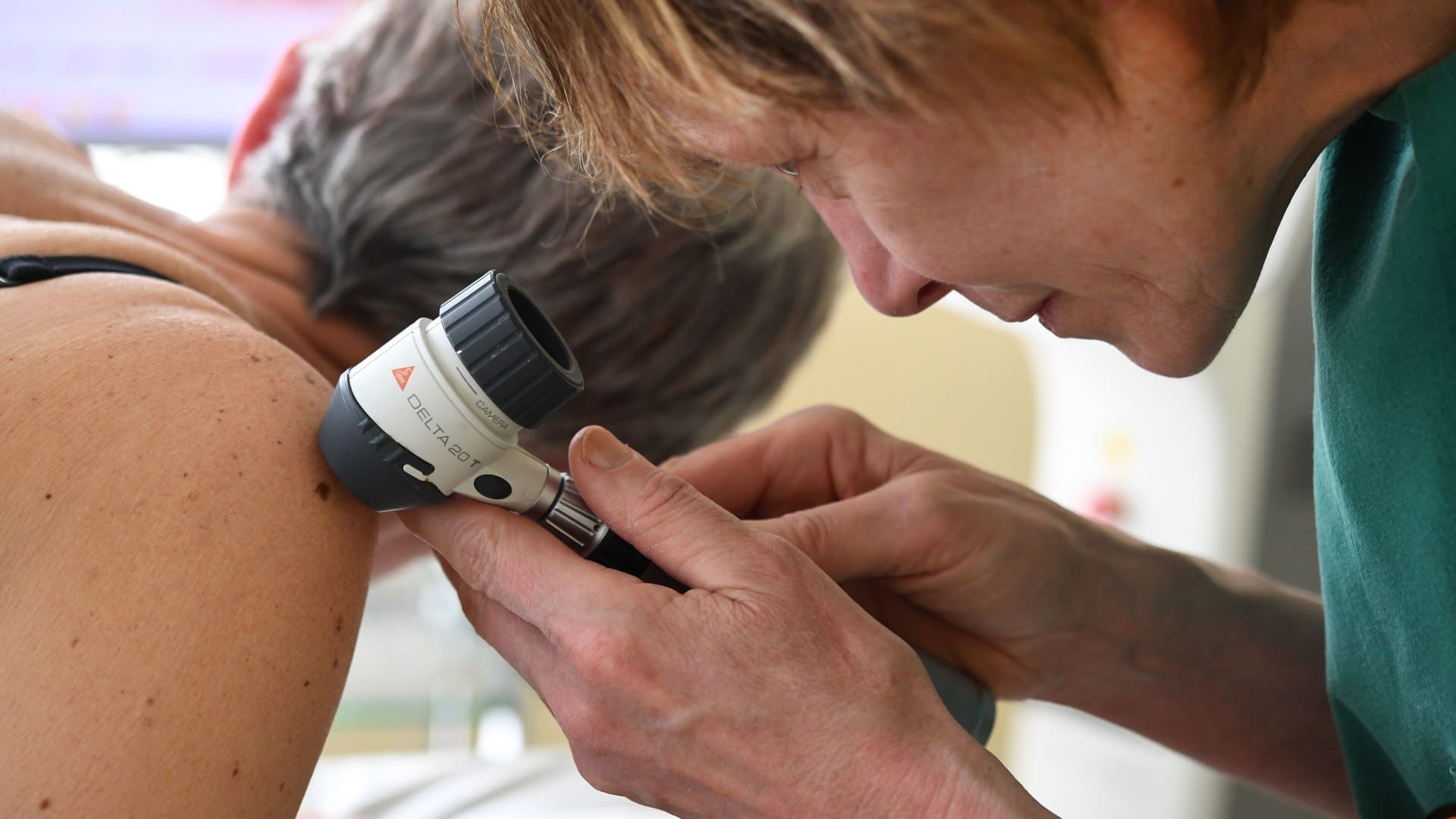About a decade ago, when he was a first-year dermatology resident, Adewole Adamson learned that “exploding” rates of melanoma were a pressing problem. That was — and still is — the official position of the American Academy of Dermatology. Since the mid-1970s, the incidence rate of melanoma, a potentially deadly cancer, has skyrocketed sixfold; once relatively rare, melanoma is now one of the most commonly diagnosed cancers in the U.S., according to the American Cancer Society.
A few years later during a research fellowship, Adamson dug into what was behind the epidemic. He was surprised to find that diagnosing more cancers wasn’t saving more lives. Mortality remained “stone-cold flat” for decades, said Adamson, who is now an assistant professor at the University of Texas at Austin’s Dell Medical School. Only recently have melanoma deaths declined, thanks to new treatments for advanced cases. Furthermore, evidence suggested that the culprit most commonly blamed for skin cancer — exposure to ultraviolet (UV) radiation from the sun or tanning beds — couldn’t account for the dramatic rise in melanoma diagnoses.
Adamson and collaborator H. Gilbert Welch, a senior investigator in the Center for Surgery and Public Health at Brigham and Women’s Hospital in Boston, tried for a year without success to publish a paper showing that UV exposure wasn’t the primary driver of the epidemic. Reviewers didn’t dispute the science, but they expressed concern that the findings might deter people from protecting themselves against the sun.
To overcome deeply ingrained notions about UV exposure and melanoma, Adamson said they needed to tell a fuller story. If not UV, then what is responsible for pushing melanoma rates ever higher? In an analysis published in the New England Journal of Medicine earlier this month, Adamson, Welch, and Benjamin Mazer, a pathologist at Johns Hopkins Hospital, make the case that medical care is to blame. By screening more people, doing more biopsies, and classifying more ambiguous lesions as cancer, health care providers have been “overdiagnosing” melanoma, flagging too many harmless skin spots that would have never proved harmful.
Overdiagnosis is a well-established — and many would say unavoidable — consequence of screening the general population for disease. The problem is particularly pronounced with cancer, where increased surveillance and new diagnostic tools allow physicians to detect small irregularities that might not be destined to spread. In a 2019 analysis of four decades’ worth of cancer statistics, Welch laid out how, for certain cancers, screening has driven up case numbers without reducing deaths. As with melanoma, for example, diagnoses of thyroid and kidney cancer have risen dramatically, while people are dying of those diseases at much the same rate as in 1975.
The pandemic pressed pause on many health screenings, providing an opportunity, I noted in a recent column, to look more closely at when routine checks help and when they are more likely to lead to unnecessary follow-up tests and treatments. In that spirit, the authors of the New England Journal of Medicine analysis advocate seizing this moment to reevaluate recommendations for skin cancer screening.
Many in the dermatology community vehemently disagree. The New England Journal of Medicine published the analysis in its “Sounding Board” section, which much like this column is a space for evidence-based commentary. “Reasonable people can look at a set of facts and come to different conclusions,” said American Academy of Dermatology President Bruce H. Thiers, adding that the journal should also have published a dissenting view.
The primary goal of screenings is to reduce deaths from melanoma, said Martin Weinstock, a professor of epidemiology and dermatology at Brown University. “If the price of reducing deaths from melanoma is too many biopsies and misleading diagnoses, that’s a price that’s worth paying.”
And yet, unnecessary cancer diagnoses have underappreciated physical, financial, and psychological harms, argues Adamson. And beyond that, he said, science — and by extension patient care — suffer when we gloss over uncertainties.
Last year, 100,000 Americans were diagnosed with melanoma and a roughly equal number with melanoma in-situ, a condition in which the cancerous cells are confined to the top layer of the skin. In-situ cancers and deeper lesions that have not spread are almost always curable. But when skin cancer spreads to other structures nearby or the lymph nodes, the five-year survival rate drops to 65 percent even with treatment. Until recently, the median survival for patients whose cancers had spread to other organs was only 8 to 12 months. But new treatments that combine immunotherapy and radiation have lengthened survival to several years for many patients.
Melanoma runs in families and it’s also more common in people with lowered immunity, said Weinstock. Melanin, the pigment that gives skin its color, helps block UV rays, which is why people with darker skin have a much lower risk of skin cancer than those with lighter skin.
Studies examining the effect of sun exposure and tanning beds show that exposure to UV radiation approximately doubles the risk of melanoma. But that doesn’t explain the extent of the increase in melanoma diagnoses, says Adamson. Even if no one in the 1970s had a history of sunburns and everyone did today, the effect would be to double the incidence rate of melanoma in the population — not push it six times higher.
What is driving the epidemic, according to the authors of the New England Journal of Medicine analysis, is a more aggressive approach to screening, biopsies, and diagnosis. Dermatologists have a financial incentive to do biopsies, said study co-author Mazer. For most physicians, it’s illegal to profit from referrals of Medicare and Medicaid patients to other medical service providers. But there are exceptions for common dermatopathology services. “Every biopsy they take, they get extra money, and, historically, skin biopsies have paid very well,” said Mazer. “It’s a good business.”
Today, the vast majority of biopsies are of small, thin lesions that under a microscope can be hard to diagnose, said Mazer. “There’s no one trump card, no one criteria really that can tell us this is absolutely, without a doubt melanoma.” Even expert skin pathologists frequently disagree when discerning harmless moles from early cancer according to a 2017 study in the British Medical Journal. Due to fear of litigation or other factors, doctors tend to err on the side of diagnosing a cancer, which helps explain why melanoma in-situ is 50 times more common now than it was in 1975.
“For sure there’s some overdiagnosis,” Weinstock said. “It’s true of other forms of cancer and it’s certainly true in melanoma where there is even more ambiguity.” But, he added, compared to 50 years ago, there’s certainly a biological increase in melanoma due to UV exposure as well. Studies that try to pinpoint the degree of risk should be taken with a grain of salt, as they are based on the sometimes unreliable memories of the persons being interviewed. “There’s a lot of uncertainty,” said Weinstock.
Thiers, the American Academy of Dermatology president, said that an aggressive approach to prevention and treatment is entirely appropriate for a disease that kills 20 Americans each day. It is difficult to determine which pigmented lesions are benign and which may turn deadly, he said, so the primary treatment is to excise the aberrant spot. “This is a small price to pay for peace of mind and far outweighs the risk of missing melanomas that could spread.”
How do you reduce overdiagnosis while not increasing the risk of overlooking potentially deadly cancers? In my conversation with Adamson, I pointed out that I don a hat and put on sunscreen when going outside for very long and report odd skin growths to my doctor. My husband, who sports a constellation of spots across his back, gets semi-regular skin cancer checks. All entirely appropriate actions, said Adamson, who specializes in treating people at high risk for melanoma. However, the most important step towards stopping the overdiagnosis cycle, he and his colleagues write, is to stop spending time and resources screening people who are not at higher risk.
Not surprisingly, Thiers disagrees. Since 1985, dermatologists have conducted more than 2.8 million free cancer checks through the organization’s public screening program, identifying more than 278,000 suspicious lesions and more than 31,500 suspected melanomas, he said. The AAD will continue to screen all comers when it’s safe to do so. “Since skin cancer, including melanoma, is highly treatable when detected early, the AAD’s free SPOT me Skin Cancer Screening Program may have helped save patients’ lives,” said Thiers. Weinstock would also expand screening, ideally, he said, by training primary care providers to do skin checks as part of routine exams.
Mazer strongly advocates for severing the financial relationships between health care providers who do the biopsies and those that examine them. That’s also a nonstarter for Thiers. In a position statement, the AAD supported the right of dermatologists to do the pathology work themselves or send it to a lab where they have a financial stake.
Some other recommendations in the New England Journal of Medicine analysis — such as limiting biopsies only to lesions larger than a pencil eraser — seem unlikely to happen in actual practice. The authors raise concern that the growing use of a lighted magnifying instrument for looking at the skin, called a dermascope, has led to more biopsies of small, harmless spots. Adamson advocates for more limited and judicious use of these devices. But Weinstock disagrees “I don’t think removing diagnostic tools from your toolbox is the answer,” he said.
Ultimately, there’s no simple fix when you are caught up in a decades-long arms race to identify more and more cancer, said Mazer. “If one side unilaterally disarms, they are called evil, uncaring,” he said. “You need pathologists, dermatologists, and patient groups, and government regulators and other policymakers to all be in agreement about this — to come together and say, ‘this is in our best interest’ — because that’s how you get these things to change.”
The heart of the debate seems to be whether people acknowledge a downside to overdiagnosis. The harms are very real, said Adamson. To start, a cancer diagnosis can prevent you from getting life insurance or short-term health insurance. It can also change how people see themselves. Adamson said that some of his melanoma patients feel guilty because they think they caused their cancer or resign themselves to spending less time outside. “I’ve had patients tell me, ‘My quality of life has diminished,’” he said.
He also worries that the problem will worsen as the system is flooded with benign abnormalities and slow-growing cancers that are not destined to spread beyond the skin. That data is then used in studies to determine peoples’ risk, as well as to train artificial intelligence systems on what cancer is and isn’t.
Adamson acknowledges that highlighting the uncertainties surrounding melanoma could muddy public health messaging. He has sympathy, he said, for those who say “I don’t want to confuse the public, I want to exaggerate a little bit to get people to do the right thing.” But nuance is important. The assumption that time outdoors has caused a skin cancer epidemic is reflected in public health advice that everyone wear sunscreen, for example, even though, as Adamson showed in a recent JAMA Dermatology analysis, there’s very little evidence that UV exposure is linked to the disease in people with darker skin.
Given that advanced melanoma is such a devastating, intractable disease, I asked Adamson: Why focus on questions of overdiagnosis that most of his colleagues don’t appear to want answered?
“Fundamentally, I think because it’s being honest,” he said. “It’s the truth.” With answers we may be able to give people better advice, better use our health care resources, or even identify some risk factor that we’ve been missing, he added. “We need to have some humility about what we know, we don’t know, and not trivialize risk, but also not exaggerate it.”











